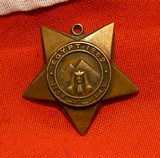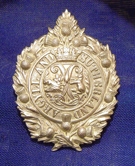Antique Arms & Militaria
A Khedive Star Medal
Five pointed star with a central raised circle bearing an image of the Sphinx with the Pyramids behind, the word ?EGYPT? above followed by a year (for the first three issues and undated for the fourth) with the same written in Arabic below. The reverse has the monogram of the Khedive under a crown within a raised circle. The Khedive of Egypt presented a bronze star to all Officers and men of the Navy and Army who were engaged in the suppression of the rebellion of Egypt in 1882. The suspender [lacking] was straight with a crescent and five pointed star in the centre which is attached to the star with a small metal loop passing through a small ring between the two top points of the star. Ist issue dated 1882. Good Very Fine condition. No ribbon,mount.Unnamed as issued. read more
65.00 GBP
Argyll and Sutherland Highlanders Glengarry Badge 1882 to 1900 Pattern
In pressed nickel with good clear definition and in good condition, 2 lugs. read more
45.00 GBP
French 1830'S Shako Helmet Plate
Brass plate of Cockerel and stamp of 'Return to Liberty' July 1830 read more
90.00 GBP
French 1830's Shako Helmet Plate.
Copper plate of a Cockerel over French symbols. read more
90.00 GBP





